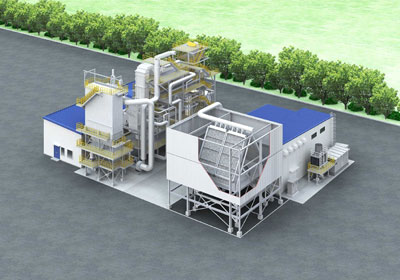Epson Plans Construction of Biomass Power Plant
Press release from the issuing company

Conceptual drawing of the Minami-Shinshu Biomass power plant
- Company's first power plant aims to use renewable electricity -
- TOKYO, Japan - Seiko Epson Corporation ("Epson") has announced that it is planning the construction of the company's first biomass power plant, in Iida City, in Nagano Prefecture, Japan. Epson hopes to have the plant in operation in the 2026 fiscal year (ending March 2027) and is moving to secure the land and buildings, contract construction, and file the paperwork for power generation.
Epson publicly committed to becoming carbon negative and underground resource free1 in Environmental Vision 2050. The use of renewable electricity is a key means by which Epson seeks to reach its goal of decarbonization and, in December 2023, Epson completed the switch to 100% renewable electricity at all Epson Group sites2 around the world.
The new power plant is intended to provide Epson with self-generated renewable electricity on a continuous basis and reduce the ratio of electricity the company purchases from external power companies, thereby promoting wider public adoption of renewable electricity. Epson plans to construct the plant on the site of the former Kiribayashi Clean Center, which the Minami Shinshu Wide-Area Union shut down in December 2017.
The electricity generated will be sold to the market under a feed-in premium (FIP) scheme3, and Epson will convert the electricity that it uses into renewable electricity by leveraging the environmental value created through power generation. Moreover, the power is expected to be supplied to local facilities in the event of a disaster or other emergency.
The power plant will not depend on fossil fuels. It will be fueled primarily by unused wood from the Minami Shinshu area, as well as by materials such as tree bark, mushroom culture medium, and some waste wooden pallets from Epson. By utilizing wood and bark from neglected forests, Epson will also be contributing to forest maintenance.
Construction of this power plant will increase the ratio of self-generated power and meet the technical criteria of RE100, which emphasizes additionality. In the future, Epson aims to create a closed-loop power plant, including by developing technology for the fixation and utilization of CO2 produced during power generation.
Epson will continue to promote the wide-spread adoption of renewable electricity, reduce its energy consumption, and circulate resources on its way to realizing Environmental Vision 2050.
Power Plant Overview
Name Seiko Epson Corporation Minami-Shinshu Biomass power plant
Location 2254-47 Kiribayashi, Iida City, Nagano Prefecture (formerly the site of the Kiribayashi Clean Center)
Lot area 32,200 m²
Energy output 1,990 kW
Estimated annual power generated 14,000,000 kWh
Main fuel sources Unused wood, bark, and mushroom media
Start of operations 2026 fiscal year ending March 2027 (planned)
1 Free of non-renewable resources such as oil and metals
2 Excludes some sales sites and leased properties where the amount of electricity consumed cannot be determined
3 Unlike in a feed-in tariff (FIT) scheme, where electricity is purchased at a fixed price, in a FIP scheme renewable electricity producers that sell electricity on a wholesale market, for example, receive a premium on top of the selling price. This helps to promote the adoption of renewable electricity.
- Questions to ask about inkjet for corrugated packaging
- Can Chinese OEMs challenge Western manufacturers?
- The #1 Question When Selling Inkjet
- Integrator perspective on Konica Minolta printheads
- Surfing the Waves of Inkjet
- Kyocera Nixka talks inkjet integration trends
- B2B Customer Tours
- Keeping Inkjet Tickled Pink
© 2024 WhatTheyThink. All Rights Reserved.















Discussion
Only verified members can comment.